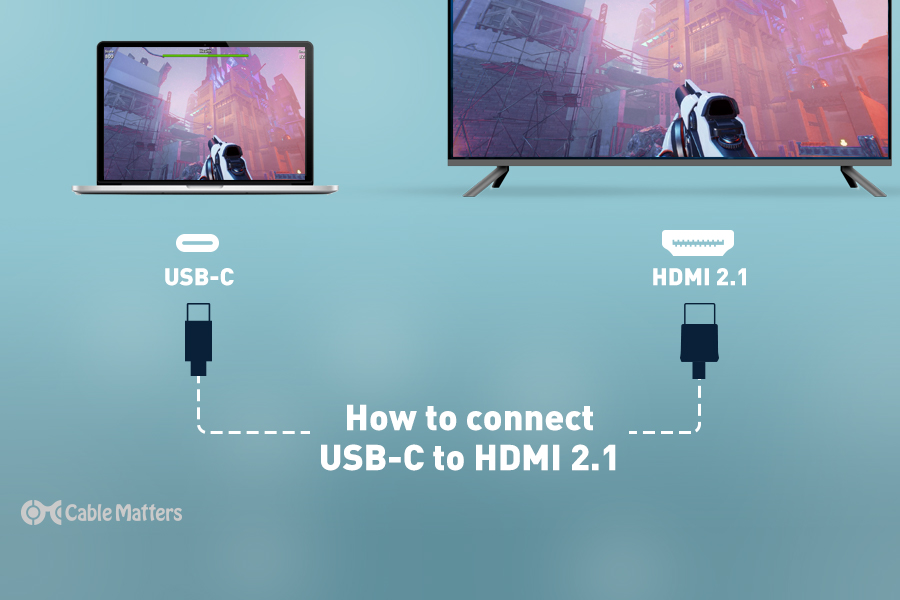
HDMI 2.1 is one of the most powerful and versatile standard today, offering unparalleled performance for immersive 8K video and buttery smooth 120Hz refresh rate 4K gaming. Not every PC or laptop that can handle such resolutions and frame rates has the right port, though. To take full advantage of HDMI 2.1's power, you need a USB-C to HDMI 2.1 adapter.
There's no reason that a system produced in the past few years that supports USB-C can't also take advantage of HDMI 2.1. You just need the right device to convert USB-C to HDMI 2.1. With the new Cable Matters adapter, it's easy.
The USB-C to HDMI 2.1 adapter unlocks a new generation of entertainment
At the high end of cinema and computer graphics, the 8K resolution could be the next great leap. Its demands are equally challenged by another ideal, though: 4K resolution at up to 120Hz. Both offer a gorgeous viewing and/or playing experience.
To utilize HDMI 2.1 natively, you'll need one of the newest generations of gaming consoles or graphics cards. It doesn't have to be that way, though. The USB-C to HDMI 2.1 adapter can connect any device from the Nvidia 2000-series (using its VirtualLink USB-C connector) to an 8K TV, or one that supports 4K at 120Hz, like the LG Signature ZX, or the Samsung Q90T.
USB-C to HDMI 2.1 adapter resolutions and features
The USB-C to HDMI 2.1 adapter has full support for 8K resolution at 30Hz using RGB 4:4:4 chroma subsampling for a flawless picture without any loss in quality. It also has full support for 4K at up to 120Hz using RGB 4:4:4 and HDR 10 – again, without any loss in quality.
Whether you can take full advantage of these will very much depend on your hardware and the bandwidth of your system's USB-C port.
What do you need to use the USB-C to HDMI 2.1 adapter?
For 8K resolution at 30Hz, you need an Nvidia RTX 2000-series graphics card from the 2060, 2070, or 2080 family. That includes all Super variants and the 2080 Ti. It is also fully supported by Intel's 11th-generation Tiger Lake line of CPUs with Xe graphics, as well as all Intel Evo certified laptops.
Note: If you have a Tiger Lake laptop with Intel Iris Xe graphics and aren't able to enable the 8K 30Hz display option when using the USB-C to HDMI 2.1 adapter, you need the latest Intel Iris drivers. Download them here.
Another common caveat you may run into is enabling 8K on your computer. Please check out this guide for a full description. Hint: On an LG 8K TV turn on the “Ultra HD Deep Color” setting, but look to enable “Enhanced Format” on a Sony Bravia TV.
That said, you won't be able to play AAA games at 8K resolution with any of these GPU solutions, as they are simply not powerful enough. Older games and indie titles should be playable at 8K if they support it, however.
If you want to play modern AAA games at 8K, the Nvidia RTX 3090 is arguably the only card that can do so with deep learning super sampling enabled. If using any of the new cards from the new Nvidia or AMD GPU ranges, they come with HDMI 2.1 as standard, so there is no need for the adapter.
For 4K resolution at up to 120Hz, the same CPUs and graphics cards apply, although you can also make use of PCs and laptops that use Intel 10th-generation Ice Lake CPUs with Intel UHD graphics.
For Apple users, recent-generation MacBooks using the same Intel CPUs, or the new Apple M1 processor developed with ARM, can support a maximum resolution and refresh rate of 4K at 60Hz without HDR when using the adapter.
The best HDMI 2.1 cables
Whether you use the USB-C to HDMI 2.1 adapter or a native HDMI 2.1 port to connect your PC, gaming console, laptop, or other devices to your 8K, or 4K 120Hz TV, you need a good quality HDMI 2.1 cable to do it. As the most powerful display cable available today, HDMI 2.1 is the best way to enjoy next-generation gaming and movie experiences.
The best HDMI 2.1 cables come in a range of sizes up to 2M, and enjoy excellent shielding for maximum signal quality no matter what you're watching or playing. They also come with gold plated connectors to help prevent corrosion.
If you need a particularly long HDMI 2.1 cable, then you'll want to opt for an active HDMI cable. Passive HDMI 2.1 cables have a maximum length that is quite limited compared to past generations: just 10ft. Active cables extend the range of HDMI 2.1 cables to 25 feet, making them much better suited to more expansive entertainment setups.
For a full FAQ on 8K compatible displays and sources, as well as specifics for the Cable Matters USB-C to HDMI 2.1 adapter, please check out this article.